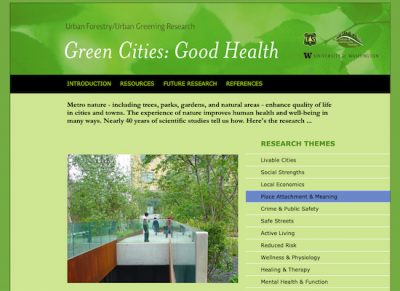Primary Functions
- Access an online compilation and synthesis of research related to urban green spaces and human health and well-being.
Detailed Description
Metro nature – including trees, parks, gardens, and natural areas – enhance quality of life in cities and towns. The experience of nature improves human health and well-being in many ways. Nearly 40 years of scientific studies tell us how.
People and Nature in Cities: More than 80% of the U.S. population, and more than 50% of all people in the world live in urbanized areas. Nature in cities and towns includes parks, gardens, trees, small landscapes, and natural areas – all providing many benefits.
This web site provides an overview of the scientific evidence of human health and well-being benefits provided by urban forestry and urban greening.
Benefits Science: Recent research has revealed the environmental benefits provided by metro nature, such as improved air and water quality, energy savings, and reduced urban heat island effects. The social sciences provide additional evidence of benefits. Nearly 40 years of research shows that the experience of nature is profoundly important to human functioning, health, and well-being.
Human Health and Well-Being Benefits: We may intuitively accept that urban nature is important for public health. This web site presents supporting evidence, confirming intuitions and expanding our knowledge. Given the high population densities of urban areas, every bit of nearby nature has the potential to benefit hundreds to thousands of people daily.
Planning for Nature: People have long recognized that nature in cities and towns provides beauty and respite. However city green improves public health – ranging from individuals to entire communities. Taken as a whole, metro nature is a “green infrastructure” system that can be planned and integrated with built systems (such as transportation and housing) to create more sustainable urban environments.





